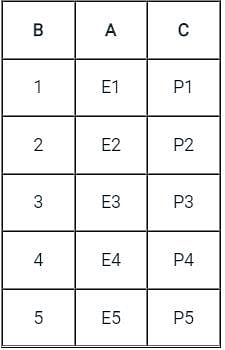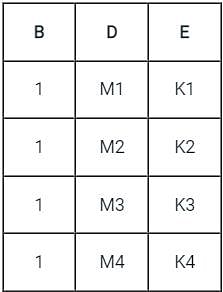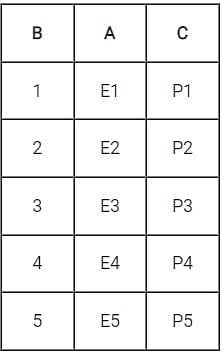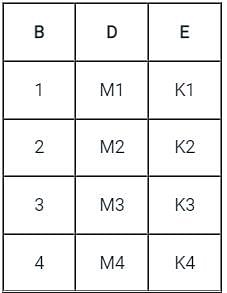Computer Science Engineering (CSE) Exam > Computer Science Engineering (CSE) Questions > The following functional dependencies hold fo...
Start Learning for Free
The following functional dependencies hold for relations R(A, B, C) and S(B, D, E)
B → A,
A → C
The relation R contains 200tuples and the relation S contains 100tuples. What is the maximum number of tuples possible in the natural join R⋈S ?
B → A,
A → C
The relation R contains 200tuples and the relation S contains 100tuples. What is the maximum number of tuples possible in the natural join R⋈S ?
- a)100
- b)200
- c)300
- d)2000
Correct answer is option 'A'. Can you explain this answer?
| FREE This question is part of | Download PDF Attempt this Test |
Most Upvoted Answer
The following functional dependencies hold for relations R(A, B, C) an...
For given relation R1(A, B, C) and R2(B, D, E), functional dependencies are given only for relation R1, not for R2 And the candidate key for R1 is B, so all values must be unique in R1. To get the maximum number of tuples in output, there can be two possibilities.
1) All 100 values of B in R2 are the same and there is an entry in R1 that matches with this value. In this case, we get 100 tuples in output.
Example:
Consider an example, suppose there is two tables R1(A, B, C) consisting of 5 tuples and R2( B, D, E) consisting of 4 tuples only.


Natural join of R1 and R2 (R1 * R2) gives: 4
2) All 100 values of B in R2 are different and these values are present in R1 also. In this case, also we get 100 tuples.
Example:
Consider an example, suppose there is two tables R1(A, B, C) consists of 5 tuples and R2( B, D, E) consists of 4 tuples only.


Natural join of R1 and R2 (R1 * R2) gives: 4
1) All 100 values of B in R2 are the same and there is an entry in R1 that matches with this value. In this case, we get 100 tuples in output.
Example:
Consider an example, suppose there is two tables R1(A, B, C) consisting of 5 tuples and R2( B, D, E) consisting of 4 tuples only.


Natural join of R1 and R2 (R1 * R2) gives: 4
2) All 100 values of B in R2 are different and these values are present in R1 also. In this case, also we get 100 tuples.
Example:
Consider an example, suppose there is two tables R1(A, B, C) consists of 5 tuples and R2( B, D, E) consists of 4 tuples only.


Natural join of R1 and R2 (R1 * R2) gives: 4
Free Test
FREE
| Start Free Test |
Community Answer
The following functional dependencies hold for relations R(A, B, C) an...
It seems like the functional dependencies are missing. Please provide the functional dependencies for relations R(A, B, C) and S(B, D, E).
Attention Computer Science Engineering (CSE) Students!
To make sure you are not studying endlessly, EduRev has designed Computer Science Engineering (CSE) study material, with Structured Courses, Videos, & Test Series. Plus get personalized analysis, doubt solving and improvement plans to achieve a great score in Computer Science Engineering (CSE).

|
Explore Courses for Computer Science Engineering (CSE) exam
|

|
Similar Computer Science Engineering (CSE) Doubts
The following functional dependencies hold for relations R(A, B, C) and S(B, D, E)B → A,A → CThe relation R contains 200tuples and the relation S contains 100tuples. What is the maximum number of tuples possible in the natural join RS ?a)100b)200c)300d)2000Correct answer is option 'A'. Can you explain this answer?
Question Description
The following functional dependencies hold for relations R(A, B, C) and S(B, D, E)B → A,A → CThe relation R contains 200tuples and the relation S contains 100tuples. What is the maximum number of tuples possible in the natural join RS ?a)100b)200c)300d)2000Correct answer is option 'A'. Can you explain this answer? for Computer Science Engineering (CSE) 2024 is part of Computer Science Engineering (CSE) preparation. The Question and answers have been prepared according to the Computer Science Engineering (CSE) exam syllabus. Information about The following functional dependencies hold for relations R(A, B, C) and S(B, D, E)B → A,A → CThe relation R contains 200tuples and the relation S contains 100tuples. What is the maximum number of tuples possible in the natural join RS ?a)100b)200c)300d)2000Correct answer is option 'A'. Can you explain this answer? covers all topics & solutions for Computer Science Engineering (CSE) 2024 Exam. Find important definitions, questions, meanings, examples, exercises and tests below for The following functional dependencies hold for relations R(A, B, C) and S(B, D, E)B → A,A → CThe relation R contains 200tuples and the relation S contains 100tuples. What is the maximum number of tuples possible in the natural join RS ?a)100b)200c)300d)2000Correct answer is option 'A'. Can you explain this answer?.
The following functional dependencies hold for relations R(A, B, C) and S(B, D, E)B → A,A → CThe relation R contains 200tuples and the relation S contains 100tuples. What is the maximum number of tuples possible in the natural join RS ?a)100b)200c)300d)2000Correct answer is option 'A'. Can you explain this answer? for Computer Science Engineering (CSE) 2024 is part of Computer Science Engineering (CSE) preparation. The Question and answers have been prepared according to the Computer Science Engineering (CSE) exam syllabus. Information about The following functional dependencies hold for relations R(A, B, C) and S(B, D, E)B → A,A → CThe relation R contains 200tuples and the relation S contains 100tuples. What is the maximum number of tuples possible in the natural join RS ?a)100b)200c)300d)2000Correct answer is option 'A'. Can you explain this answer? covers all topics & solutions for Computer Science Engineering (CSE) 2024 Exam. Find important definitions, questions, meanings, examples, exercises and tests below for The following functional dependencies hold for relations R(A, B, C) and S(B, D, E)B → A,A → CThe relation R contains 200tuples and the relation S contains 100tuples. What is the maximum number of tuples possible in the natural join RS ?a)100b)200c)300d)2000Correct answer is option 'A'. Can you explain this answer?.
Solutions for The following functional dependencies hold for relations R(A, B, C) and S(B, D, E)B → A,A → CThe relation R contains 200tuples and the relation S contains 100tuples. What is the maximum number of tuples possible in the natural join RS ?a)100b)200c)300d)2000Correct answer is option 'A'. Can you explain this answer? in English & in Hindi are available as part of our courses for Computer Science Engineering (CSE).
Download more important topics, notes, lectures and mock test series for Computer Science Engineering (CSE) Exam by signing up for free.
Here you can find the meaning of The following functional dependencies hold for relations R(A, B, C) and S(B, D, E)B → A,A → CThe relation R contains 200tuples and the relation S contains 100tuples. What is the maximum number of tuples possible in the natural join RS ?a)100b)200c)300d)2000Correct answer is option 'A'. Can you explain this answer? defined & explained in the simplest way possible. Besides giving the explanation of
The following functional dependencies hold for relations R(A, B, C) and S(B, D, E)B → A,A → CThe relation R contains 200tuples and the relation S contains 100tuples. What is the maximum number of tuples possible in the natural join RS ?a)100b)200c)300d)2000Correct answer is option 'A'. Can you explain this answer?, a detailed solution for The following functional dependencies hold for relations R(A, B, C) and S(B, D, E)B → A,A → CThe relation R contains 200tuples and the relation S contains 100tuples. What is the maximum number of tuples possible in the natural join RS ?a)100b)200c)300d)2000Correct answer is option 'A'. Can you explain this answer? has been provided alongside types of The following functional dependencies hold for relations R(A, B, C) and S(B, D, E)B → A,A → CThe relation R contains 200tuples and the relation S contains 100tuples. What is the maximum number of tuples possible in the natural join RS ?a)100b)200c)300d)2000Correct answer is option 'A'. Can you explain this answer? theory, EduRev gives you an
ample number of questions to practice The following functional dependencies hold for relations R(A, B, C) and S(B, D, E)B → A,A → CThe relation R contains 200tuples and the relation S contains 100tuples. What is the maximum number of tuples possible in the natural join RS ?a)100b)200c)300d)2000Correct answer is option 'A'. Can you explain this answer? tests, examples and also practice Computer Science Engineering (CSE) tests.

|
Explore Courses for Computer Science Engineering (CSE) exam
|

|
Suggested Free Tests
Signup for Free!
Signup to see your scores go up within 7 days! Learn & Practice with 1000+ FREE Notes, Videos & Tests.
























